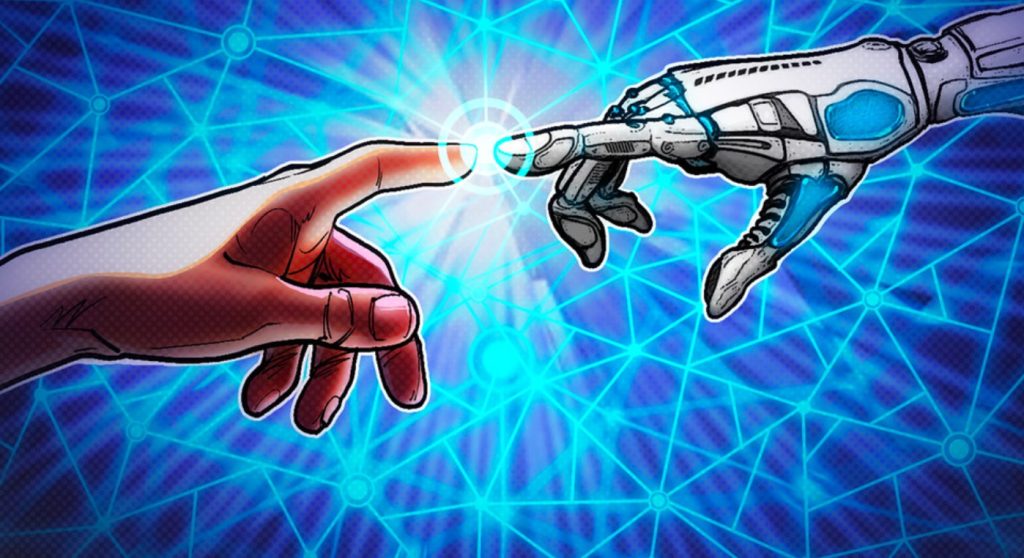
1. What is a metaverse?
A harbinger of the new era of digital connectivity, the metaverse combines blockchain with AI (artificial intelligence), VR (virtual reality) and AR (augmented reality), collectively known as XR (extended reality) experiences.
A metaverse is a 3D virtual world accessed through a VR headset. Users can navigate this world through their eye movements, voice commands and feedback controllers. With the headset, the user can feel the immersive world and see the metaverse in action. People interact with each other via avatars and participate in activities like gaming, shopping and more.
According to a report by Emergen Research, the metaverse market will reach across $800 billion by 2028. Applications of metaverse technology include gaming, education, commerce, government services, socializing and many more.
2. What is AI?
AI refers to machines simulating human intelligence processes.
AI is a branch of computer science focused on building smart machines capable of mimicking human intelligence. Algorithms powering AI systems analyze colossal amounts of labeled training data for correlations and patterns, and use these patterns to come up with predictions. AI systems can process data much faster and more accurately than humans.
Applications of AI include smart assistants like Alexa, self-driving cars, conversational bots, Robo advisors, email spam filters, etc. and now, metaverses. As a result, how AI will shape the metaverse has become a regular topic of discussion in tech circles.
3. How do AI, blockchain and XR work together?
The technologies involved infuse tons of potential use cases in the metaverse, leaving imagination as the only restriction.
XR has created a virtual world that never existed before. Blockchain brings decentralization, resulting in the elimination of the centralized governing authority, transparency and irreversible transactions.
Nonfungible tokens (NFTs), a core component of the metaverse, are a product of the blockchain. All objects in the metaverse — land, vehicles, ships, gift items — are also basically NFTs. Take out NFTs and the metaverse falls crashing.
Artificial intelligence in the metaverse enables you to overcome obstacles like poor interactive quality and create new products such as live virtual conferences. It adds to the intuitive interfaces and predictive capabilities of the metaverse. This not only makes life easier for the avatars but games more dynamic, interactions more engaging and businesses more successful.
4. What were the challenges hindering the metaverses?
Metaverse technology has been confronting challenges that stemmed from its immense growth potential.
As technologies, the VR and AR of the previous era had their limitations such as a lack of vision of the surroundings and graphical restrictions. Activities on the metaverse are simply not as engaging as those in the real world or even regular online games.
Self-reliance is another aspect where many metaverses were struggling. In the initial phase of the metaverses, there was simply not enough technical sophistication and footfalls to create adequate use cases to keep the economy rolling. Thanks to advancements in VR and AR, and the integration of metaverses with AI, use cases are increasing and subsequently, options for monetization.
Like any new technology, metaverses were also facing adoption issues, though this is gradually changing with projects like Decentraland (MANA), The Sandbox (SAND) and now MeetKai metaverse. On Decentraland, participants can buy and sell virtual real estate while exploring exhilarating games. Sandbox offers a gaming ecosystem that enables users to create, share and monetize gaming assets whereas Meetkai has created a realistic metaverse that is qualitatively better than the real world, thanks to its integration with AI.
The sophisticated integration of XR and AI technologies has resulted in more engaging virtual worlds, resulting in better adoption and subsequently, more revenues for all stakeholders in the ecosystem.
5. What is the mixed reality metaverse?
The amalgamation of AI with XR has led to the phenomenon of mixed reality (MR) metaverse.
To date, human-AI interaction has been usually limited to the B2B world. However, projects are emerging now that showcase AI integration into B2C. Meetkai, for instance, demonstrates how efficient life could be with human-AI integration. Leveraging AI-enabled tech, Meetkai enhances regular real-life experiences like shopping, working in an office and engaging in outdoor activities like hiking, trekking, etc.
While lying in their beds, users can not only try apparel in the metaverse store of their favorite brand and bargain with the sellers live but also have their purchases delivered to their doorsteps. They can also work in their virtual office with a complete set of productivity tools.
Look around and you will find a staggering number of metaverse projects on games, say Roblox, Blocktopia, Nakamoto and so on. This suggests that the arrival of the mixed reality metaverse is an epoch-changing event in the domain of metaverses.
6. How will conversational AI shape the metaverse?
Conversational AI systems in the metaverse resemble human-to-human communication.
Voice assistant AI has found its way to the metaverses of the new era, powering use cases like lifestyle assistance and personalized recommendations. For instance, rather than driving to a travel agency’s office or talking to their overburdened customer service, users can hop on the metaverse and take a tour of multiple awe-inspiring locations with the assistance of an AI-powered bot.
An AI concierge in a metaverse is a personified machine that delivers unique recommendations based on the avatar’s preferences. Take into account the amount of data available on every person and you know the potential of this use case.
Natural language processing in the metaverse makes it more personal than the real world. Voice AI can interpret avatar requests in a language that is more human and natural while factoring in individual tastes and preferences.
Speech technology has become more contextual and personalized, making the metaverse interface smarter in the process. For instance, Kai, the first AI concierge on Meetkai, has made voice assistance as easy as talking with a friend. Request a recipe for “steak” by saying, “Hey Kai, can you find me a nice recipe?” And you’ll receive the most delectable beef steak recipe in the world in seconds.

7. How does XR create deep collaboration in the metaverse?
XR felicitates dynamic collaboration in the metaverse, enabling white-collar work in an intimate office environment.
A metaverse driven by AI enables users to take up tasks that are much more fun, engaging and impactful. For instance, in a natural conversation about different topics in various realities, MeetKai’s conversational AI can comprehend more sophisticated speech, provide personalized outcomes and quickly respond by remembering user preferences and context.
Furthermore, an XR device provides for data overlay, opening up a string of applications. In a metaverse, this is immensely useful for building or manufacturing use cases. An XR-backed environment creates a feeling of togetherness, a critical component of a closely-knit office atmosphere.
XR is especially efficient when there is a small set of criteria to be met. For instance, when doing something as simple as playing a board game, you may want dim light and particular music. An interactive XR atmosphere can determine what you want and arrange for it. A virtual conference room can be decisively better than the one in real life.
























